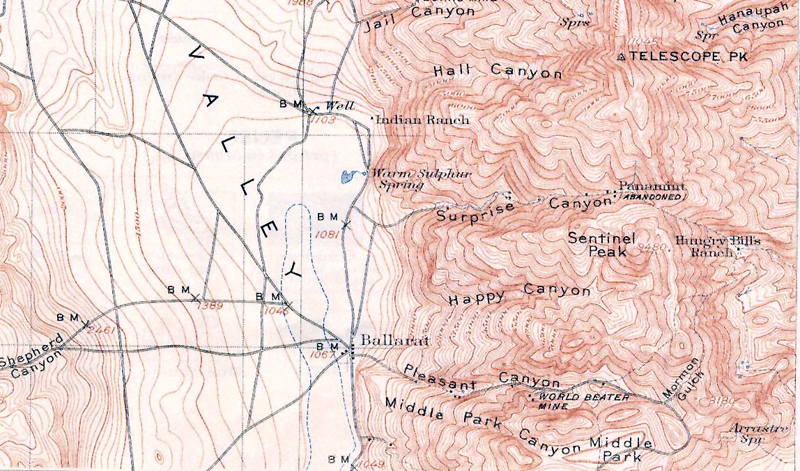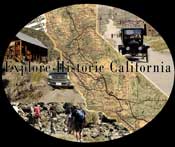|
In the 1870’s
as the Panamint Valley mines sprouted, a little spring a quarter
mile south of Pleasant Canyon earned it’s place in history as a
waterhole and communication center. It has also been recorded that
the outlaws that were tucked away deep within the canyons of the
Panamint Mountains took advantage of this spot as well. An agreement
of sorts was made with particular drivers of the Caesar Myerstein
Panamint Stage Line. The bandits would leave letters and cash in a
box that was wired in the fork of a mesquite tree located at the
spring. Upon the return trip, the stage driver left requested
provisions, where they could be picked up without fear of ambush. By
the 1890’s this spot which was called Post Office Springs because of
these transactions between bandit and stage drivers, supported a
tiny general store run out of a canvas tent to meet the supply needs
of prospector and freighters. A blacksmith shop followed the general
store. The ground surrounding the spring was deemed too green and
marshy for a full blown Main Street, however, so a half a mile away
in the desert flats, the town of Ballarat was plotted.
 |
|
Ballarat and
vicinity as shown on 1908 USGS topographic map. |
Forty out of
eighty acres set aside for the new town site, were laid out in lots
March of 1897. These lots were grabbed quickly for prices ranging
anywhere from $10 to $75. By the end of March two saloons were
dispensing as much as 15 gallons of whisky a day to parched miners.
A general store, and at least a dozen tents sprang up as well.
Within another two months four saloons, two general stores, two
restaurants, three feed yards, an assay office, and one hotel served
a booming population of well over one hundred. When the citizens
met to choose a name for their town, an Australian suggested naming
it after the famous gold mining town from his native country. The
desert site they had proudly dubbed “The Mining Camp of the Desert”
became officially known as Ballarat.
By July 4,
1897, the population of Ballarat doubled with another one hundred
miners trickling down the mountains for patriotic celebrations. The
camp came to life with foot and burro races, hammer throwing, tug of
war, and the obligatory informal drinking bouts. On the 21st
of the same month, a post office was established with storekeeper
John S. Stotler appointed post master. Two stage coaches, and two
small custom mills came to Ballarat. The mills were gasoline powered
with a total of eighteen stamps that ran high grade ore samples from
the various mines that continued to open up throughout the western
side of the wall of mountains that separated the Panamint and Death
Valleys. As the year went on the Inyo County Supervisors appointed
Richard Decker the Justice of the Peace.
Nearly three
hundred men worked in the mines surrounding the supply and
recreation town of Ballarat as the turn of the 20th
century came around. Mines known as Ratcliff, World Beater, Oh Be
joyful, and Gem were pulling out a total of $500,000 in bullion. In
turn Ballarat boomed with a fine two story hotel complete with shady
veranda, a school of thirty-one pupils (eight of which were
Indians), a red light district complete with half a dozen cribs, an
impromptu “Shake-em-up Band, and a jail. If the bullion didn’t make
the men “Oh Be Joyful” enough, the girls at those half a dozen cribs
surely did.
While
Ballarat had its share of drinking, carousing, and ruckus, and an
official house of God never joined the ranks of adobe, wooden and
canvas businesses, the citizens managed to survive relatively
peacefully. During a three year period only three deaths were
reported, and those were from illness, not at the hands of each
other. The Fourth of July continued to be a great source of
excitement, particularly the year young ladies came over from
Bakersfield to compete in a burro race for a quarter interest in the
Hot Cake Claim. Then there was the unhappy customer of the Porter
Brothers General Store. Angry over 700% price gouging, a stick of
giant powder was placed on the store owners bedroom window in the
middle of the night. Ballarat woke up to the explosion, of course,
took note of the home with the blown away wall, found residents
escaped completely intact, then went back to the business of
sleeping until the sun rose again the next day.
The only
homicide in Ballarat can be attributed to the lawmen of the day on
October 1905 when Constable Henry Pietsch gunned down Justice of the
Peace Richard Decker. Although Ballarat was never a “man for
breakfast” sort of camp, John Calloway posted signs in each of the
rooms at his Ballarat Hotel stating that the management was “not
responsible for either their lives or their valuables,” nor would
they pay for any part of funeral expenses.
The mines
surrounding Ballarat boomed and busted on and off until 1905,
producing nearly a million dollars in gold, making it Death Valley’s
most productive hard-rock district. “The Mining Camp of the Desert”
was no longer needed as a central point for supplies and
entertainment, and was all but abandoned for new prospects in
Bullfrog . On September 29, 1917 the few hardy desert rats who
remained in Ballarat watched as the post office closed it’s doors
and moved to Trona.
In spite of
its lonely desolated location, Ballarat never went totally to the
ghosts. A few colorful residents like Chris Wicht and Seldom Seen
Slim stuck it out. In the 1960’s the place gained fame as the
closest town to Barker Ranch where the Charles Manson clan hid out,
and the modern millennium legend of the Ballarat Bandit still draws
the curious. Someone is always living in the remnants of the old
town, ready to talk about the old days and show you around should
you wander in on your way to Death Valley. Backpackers, campers,
modern miners, and desert history buffs still use the place as a
jumping off spot for their desert adventures. At least once a year,
the population of Ballarat swells with anywhere from 100-200 red
shirted beer drinking history loving members of E Clampus Vitus, and
the drinking, carousing, and ruckus is alive once again.
Bibliography:
|
